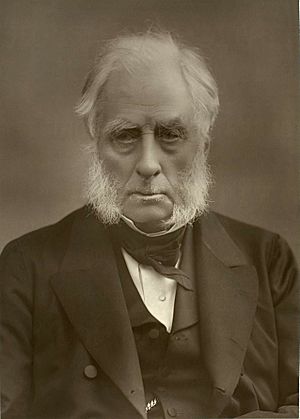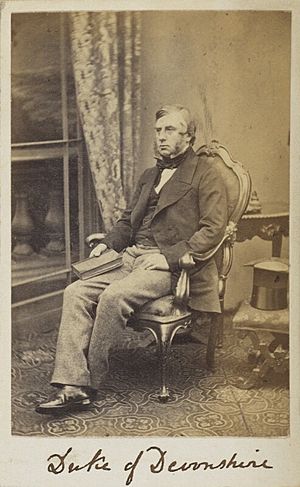William Cavendish, 7th Duke of Devonshire facts for kids
Quick facts for kids
The Duke of Devonshire
|
|
|---|---|

The 7th Duke of Devonshire, by Herbert Rose Barraud, c. 1880s
|
|
| Member of Parliament for North Derbyshire | |
| In office 1832–1834 Serving with Thomas Gisborne
|
|
| Preceded by | New constituency |
| Succeeded by | Thomas Gisborne Lord George Henry Cavendish |
| Member of Parliament for Malton | |
| In office 1831–1831 Serving with Henry Gally Knight
|
|
| Preceded by | Francis Jeffrey Henry Gally Knight |
| Succeeded by | Henry Gally Knight Charles Pepys |
| Member of Parliament for Cambridge University | |
| In office 1829–1831 Serving with The Viscount Palmerston
|
|
| Preceded by | The Viscount Palmerston Sir Nicholas Conyngham Tindal |
| Succeeded by | Henry Goulburn William Yates Peel |
| Personal details | |
| Born | 27 April 1808 |
| Died | 21 December 1891 (aged 83) Holker Hall, Cartmel, Cumbria |
| Resting place | St Peter's Church, Edensor |
| Nationality | British |
| Political party | Whigs |
| Spouse | |
| Children | 5, including Spencer Cavendish, 8th Duke of Devonshire Lord Frederick Cavendish Lord Edward Cavendish |
| Parents | William Cavendish Louisa O'Callaghan |
| Alma mater | Trinity College, Cambridge |
| Awards | Smith's Prize (1829) |
William Cavendish, 7th Duke of Devonshire (born April 27, 1808 – died December 21, 1891) was an important British landowner, supporter of good causes, nobleman, and politician. He was known by different titles during his life, including Lord Cavendish of Keighley and the Earl of Burlington, before becoming the Duke of Devonshire.
Contents
Early Life and Education
William Cavendish was the son of William Cavendish and Louisa O'Callaghan. His family was very well-known and connected to many important people in Britain. His great-grandfather was the 4th Duke of Devonshire.
William went to Eton College, a famous school, and then studied at Trinity College, Cambridge, one of the colleges at the University of Cambridge. He was very good at math! He earned a special award called the Smith's Prize for his skills in mathematics. In 1831, he received the courtesy title of Lord Cavendish of Keighley.
A Career in Politics and Education
William Cavendish started his political career as a Member of Parliament (MP). This means he was elected to represent people in the British government.
- He was an MP for Cambridge University from 1829 to 1831.
- He also served as an MP for Malton and North Derbyshire.
In 1834, he became the Earl of Burlington. Later, in 1858, he inherited the title of Duke of Devonshire from his cousin. This meant he became a member of the House of Lords, which is part of the British Parliament. He also held important roles as Lord-Lieutenant of Lancashire and Lord-Lieutenant of Derbyshire, which meant he was the Queen's representative in those areas.
The Duke of Devonshire was also very involved in education:
- He was the Chancellor of the University of London for 20 years (1836-1856).
- He became the Chancellor of the University of Cambridge in 1861 and held this position until his death.
- He was also the Chancellor of the Victoria University.
At Cambridge, he made a huge impact. He helped fund the creation of the Cavendish Professorship of Physics and the building of the famous Cavendish Laboratory. This laboratory became a world-leading center for scientific research.
He also invested a lot of money in heavy industries in Barrow-in-Furness. After a fire in 1871, he had his country house, Holker Hall, rebuilt. He was also one of the people who helped start the Royal Agricultural Society of England in 1839.
Developing Eastbourne
The 7th Duke inherited a lot of land in a town called Eastbourne. He played a big part in developing Eastbourne during the 1800s. He helped plan its parks, baths, and squares. There's even a statue of him in Eastbourne to remember his contributions!
He also helped start Eastbourne College, a local private school. He sold some of his land at a low price so the school could be built. He also hired a well-known architect, Henry Currey, to design the school's chapel and main building.
Family Life
In 1829, William Cavendish married Blanche Georgiana Howard (1812–1840). She was the daughter of the 6th Earl of Carlisle. Sadly, Blanche passed away in 1840. The Duke remembered her in many ways, including an inscription at Chatsworth House and a special urn in the garden.
Together, William and Blanche had five children:
- William Cavendish, Lord Cavendish of Keighley (1831–1834)
- Spencer Cavendish, 8th Duke of Devonshire (1833–1908), who later became the 8th Duke.
- Lady Louisa Caroline Cavendish (1835–1907)
- Lord Frederick Cavendish (1836–1882), who sadly died in Dublin in 1882 while serving as Chief Secretary for Ireland.
- Lord Edward Cavendish (1838–1891), who was also a Member of Parliament.
The Duke of Devonshire passed away on December 21, 1891, at his home, Holker Hall, in Cumbria, England.
Images for kids
-
Grave of the 7th Duke of Devonshire at St Peter's Churchyard, Edensor.



